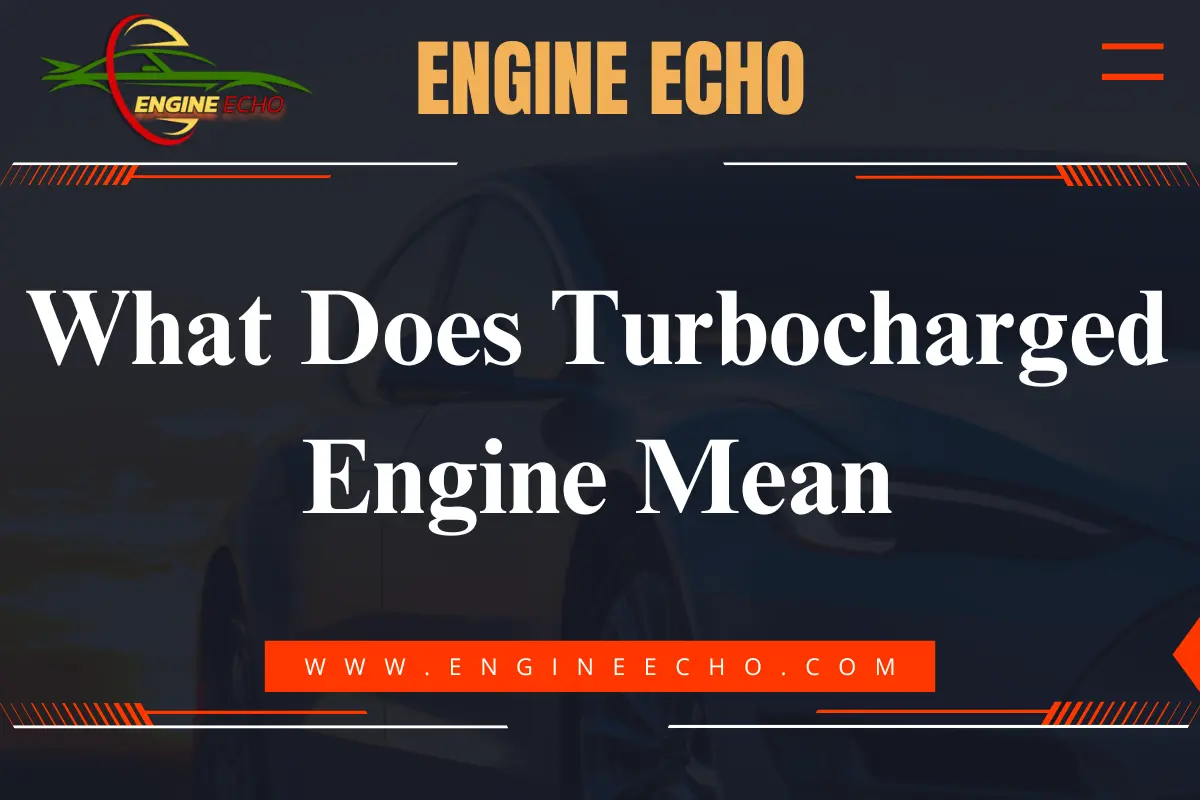What Does Turbocharged Engine Mean?

Key Takeaway
A turbocharged engine is like a secret weapon for your vehicle, boosting performance without making the engine larger. It’s all about efficiency, power, and having a bit more fun on the road!
Introduction
If you’ve ever wondered why some cars seem to have that extra kick when you hit the gas, you’re probably looking at a turbocharged engine. This innovative piece of technology has transformed the way we think about vehicle performance. Imagine getting more power and efficiency from a smaller engine—sounds pretty appealing, right? In this article, we’ll dive into what turbocharged engines are all about, how they work, and why they might just be the perfect fit for your next vehicle.
What Does Turbocharged Engine Mean?
Let’s talk about turbocharged engines. If you’re like me and have a soft spot for cars, you’ll find this topic fascinating. A turbocharged engine is an exciting innovation in automotive engineering designed to maximize performance without draining your wallet at the gas station. At its core, a turbocharger is a nifty little device that forces more air into the engine’s combustion chamber, letting it burn more fuel and produce more power. Basically, it’s the engine’s way of saying, “Let’s do this!”
Understanding the Basics of Turbocharging
Okay, let’s break it down a bit. A turbocharger consists of two main components: the turbine and the compressor.
- The Turbine: This is where the magic begins! The turbine is powered by exhaust gases from your engine. When you hit the accelerator, those gases spin the turbine at crazy speeds—think over 100,000 RPM! It’s like a mini rollercoaster ride under the hood.
- The Compressor: Connected to the turbine, the compressor draws in air from outside and compresses it. This makes the air denser, allowing more of it to sneak into the combustion chamber. More air means more fuel, and more fuel means more power!
- Intercooler: Ever heard of an intercooler? It’s a cool little component that lowers the temperature of the compressed air before it goes into the engine. This extra cooling makes the air denser, helping your engine perform at its best. It’s like giving your turbocharger a refreshing drink of water before it gets to work!
- Wastegate: Now, let’s talk about the wastegate. It regulates how much exhaust gas goes to the turbine, keeping everything running smoothly. Think of it as a traffic cop, making sure the turbo doesn’t get overwhelmed.
How Turbocharging Works
So, how does this all come together? Here’s the deal:
- Exhaust Gas Production: Every time you fire up your engine, it produces exhaust gases as a byproduct of combustion. These gases are packed with energy that can be used to enhance performance.
- Spinning the Turbine: When those exhaust gases exit your engine, they flow into the turbocharger, spinning the turbine. This action creates rotational energy that powers the compressor, and off we go!
- Compressing Air: The compressor kicks into gear, drawing in ambient air and compressing it. This extra boost in air density allows your engine to burn more fuel, making for a powerful ride.
- Enhancing Combustion: With the additional compressed air, more fuel can be injected into the combustion chamber, leading to an explosive burst of power that makes driving a turbocharged car so thrilling.
- Exiting Exhaust: After combustion, the exhaust gases exit the engine and continue to spin the turbine, creating a continuous cycle. It’s a beautifully efficient system!
Benefits of a Turbocharged Engine
Turbocharged engines bring a lot to the table. Here are some key benefits:
- Increased Power: Turbocharging allows smaller engines to produce more horsepower than naturally aspirated engines of the same size. I remember my first ride in a turbocharged vehicle, feeling that surge of power as I hit the gas. It was a game changer!
- Better Fuel Efficiency: Turbocharged engines can extract more energy from the same amount of fuel. This often translates to better fuel economy, especially during highway driving. It’s nice to save a bit at the pump, isn’t it?
- Reduced Emissions: By burning fuel more efficiently, turbocharged engines can emit fewer harmful gases. In today’s world, where we’re all trying to be a bit kinder to the planet, this is a big win.
- Compact Design: Turbochargers let smaller engines produce power comparable to larger engines, helping to reduce vehicle weight and improve handling. Less weight means more fun on the road!
- Enhanced Performance Across RPM Range: Turbochargers provide consistent power delivery across the engine’s RPM range. The thrill of merging onto a busy freeway and feeling that instant response? Priceless!
- Tuning Potential: Turbocharged engines are great for car enthusiasts who love to tweak their rides. With some aftermarket modifications, like upgraded turbochargers or intercoolers, you can crank up the horsepower significantly.
Common Applications of Turbocharged Engines
Turbocharged engines have become a staple in various vehicles, from everyday cars to high-performance sports models. Here are some common applications:
- Sports Cars: Many modern sports cars boast turbocharged engines to deliver the power and speed enthusiasts crave. Brands like Porsche, BMW, and Audi have embraced this technology, and let me tell you, the driving experience is exhilarating.
- Sedans and SUVs: Increasingly, manufacturers are equipping their sedans and SUVs with turbocharged engines. Models like the Ford Escape and Honda CR-V are great examples. I’ve driven both, and I can vouch for their impressive blend of power and practicality.
- Trucks: Turbocharged engines are also popular in the truck segment. Pickup trucks often use turbocharging to boost torque for towing and hauling. Brands like Ford have introduced turbocharged V6 engines that provide excellent performance while improving fuel efficiency.
- Motorsport: Turbocharged engines have a long history in motorsports, where performance is everything. From rally cars to Formula 1, the advantages of turbocharging shine in competitive racing.
Considerations When Choosing a Turbocharged Engine
While turbocharged engines offer many benefits, there are also a few considerations to keep in mind:
- Maintenance: Turbocharged engines may require more maintenance than naturally aspirated engines. Regular checks on the turbocharger and related components are essential to keep everything running smoothly.
- Turbo Lag: Although modern turbochargers have significantly reduced turbo lag, it can still be a factor, especially in older models. You know that feeling when you press the accelerator, and there’s a split second before the power kicks in? Thankfully, advancements in technology have made this less of an issue.
- Heat Management: Turbocharging generates additional heat, which can be tough on your engine if not managed properly. Ensuring adequate cooling through intercoolers and keeping an eye on oil levels is crucial for longevity.
- Driving Style: How you drive matters. Frequent heavy acceleration can put extra stress on the turbo, so it’s essential to find a balance between enjoying that power and taking care of your engine.
- Fuel Quality: Turbocharged engines often perform best on higher-octane fuel. Always check the manufacturer’s recommendations regarding fuel quality to avoid knocking or performance issues.
Conclusion
So, what’s the bottom line? A turbocharged engine is a thrilling advancement in automotive technology that strikes a fantastic balance between power and efficiency. I’ve found that driving a turbocharged vehicle feels like a whole new experience—one that’s both exhilarating and economical. As manufacturers continue to innovate, the future of turbocharging looks bright, promising even more exciting developments.
If you’re considering a new vehicle, I highly recommend exploring models with turbocharged engines. Trust me; once you experience that power and efficiency, you won’t want to go back. So, why not take a test drive? You might discover a whole new level of driving fun waiting for you!
FAQs
1. What is a turbocharged engine?
A turbocharged engine uses a turbocharger to force more air into the combustion chamber, allowing for more fuel to be burned, resulting in increased power output without the need for a larger engine.
2. How does a turbocharger work?
A turbocharger uses exhaust gases to spin a turbine, which then powers a compressor that draws in and compresses air before it enters the engine. This process improves combustion and boosts power.
3. What are the benefits of having a turbocharged engine?
Turbocharged engines typically offer increased power, better fuel efficiency, reduced emissions, and a more compact design, all while enhancing overall performance.
4. Are there any drawbacks to turbocharged engines?
While they offer many benefits, turbocharged engines can require more maintenance, may experience turbo lag, and can generate additional heat that needs to be managed. They may also require higher-octane fuel for optimal performance.
5. What types of vehicles use turbocharged engines?
Turbocharged engines are commonly found in sports cars, sedans, SUVs, and trucks. They are increasingly popular in a wide range of vehicles due to their power and efficiency advantages.
Thanks for checking out this article on EngineEcho.com! Hope you found this article: "What Does Turbocharged Engine Mean?" helpful! If you liked it and want to dive into more car engine topics, head over to our homepage. There's always something new to discover in the world of engines. Enjoy your reading journey!
Check out our previous article: Recognizing the Signs of Low Engine Oil






